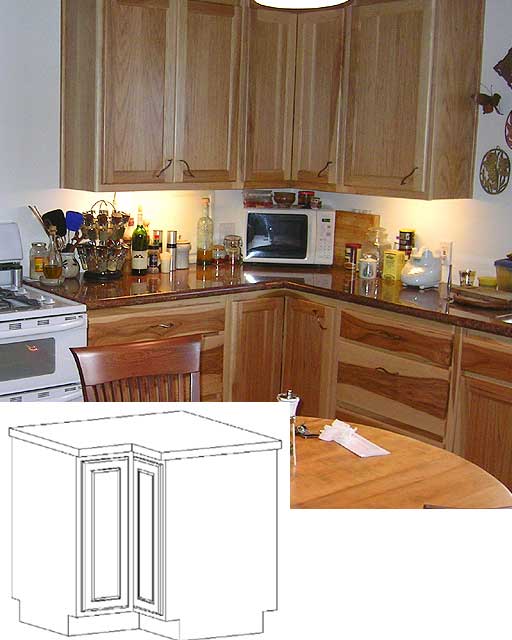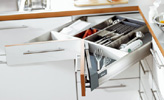Beyond the Lazy Susan: Corner Cabinet Options
Not everyone loves the Lazy Susan cabinet. Here's a discussion of alternative ways to provide easy-reach storage in corner cabinets. December 28, 2005
Question
One of my customers wants a lazy susan. I opened my CH Briggs catalog and my disdain for lazy susan’s grew even greater. Does anyone out there have a favorite lazy susan?
Forum Responses
(Cabinetmaking Forum)
From contributor D:
I have been able to talk every customer I have out of a lazy susan, in exchange for an easy reach corner cabinet instead. You actually gain a few more square inches of storage and don't have to worry about bearings going out on the turn style.
From contributor D:
Below is a representation of an upper and lower easy reach cabinet. They look very similar to a lazy susan cabinet, only the middle shelf is fixed and extends all the way to the back of the cabinet. I then use the "Piecut" European hinges on the doors so they open fully to give you complete access to the cabinet.

Click here for full size image
From the original questioner:
To contributor D: So you give them one pie shaped 30" deep shelf accessible by euro style bifold doors? I would have an easier time getting my customers to accept a bank of drawers at 45 degrees.
From contributor D:
A bank of drawers is a good option also, but you loose a great number of square inches of storage that way. If you customer is asking for a lazy susan, I doubt she/he would go for a bank of drawers, but they may go with an easy reach. They are essentially the same cabinet without the turn style and the doors mounted to the turn style.
If you/them are willing to go with a 45 degree cabinet face, make an easy reach without the piecut front, and make it a 45 degree instead. Now you've gained even that much more square inches of storage. Be aware though, you will need a minimum of a 35" opening through any door or doorway to get that cabinet into the house, due to it being 36" x 36". If you flip it on its side it'll only be 35".
From contributor N:
I like the idea of the drawers in the corner. Yes, you may lose some space, but it is much more ergonomic to pull out a drawer and remove what you want than it is to bend over and reach back into a fixed shelf to get something shoved in the back, or if you have a susan, to reach back and grab the things that fell off the tray and are now on the floor of the cabinet. One thing with the corner drawers is to make the cabinet a 42 x 42 instead of a 36 x 36 as it gives you some pretty good sized drawers. The Tandembox space corner system below works very well.

From contributor H:
I don’t like lazy susans either, but a good quality unit from Peter Meir or Rev-A-Shelf will stand up to a lot of wear. I have shown my clients that extending a 3 drawer cabinet (6"/12"/12") into each corner with a filler so that the handles clear each other actually gives them more usable cubic feet of storage that is easily accessible. The
Blum corner unit is also a good option but very pricey.
From contributor C:
To contributor N: Be careful making your corner cabinet that large. You may not be able to get it into the house without disassembling it at the job site.
From contributor N:
When I make them that big I do a detached toe kick. The cabinets then are only 30" tall so when put on their back they fit through doors easily. Of course there are limitations to that also, but as long as you pay attention to the project and where it is going, it is never an issue.
From contributor B:
I like the easy reach cabinets too. We make two adjustable shelves in the lowers; the top one is 8" deep on the two legs, the lower shelf is 16" deep on each leg. With this setup you can see everything on each shelf; nothing is "behind all that stuff". Sure, some space is wasted, but everyone we have done this for thinks it is great. The only way to use all the space is to bury most of what is in there.
From contributor K:
Like others, we've done a lot of the above, but over the years we've come up with a solution that customers seem to really like. We call it a super-susan (sounds better than lazy). We've since seen versions of it on the market.
We make our own susan platters, and attach them on the bottom of the cabinet, and on a middle shelf, so they are actually sitting on a platform. We also make the middle shelf/platter adjustable so they can even put large pots and pans on the bottom and whatever on the middle shelf, as height is less of an issue. Nice thing about it is that they no longer have to worry about items falling off the susan, as it has a 1 1/4" side lip (total of 2 1/2", minus 3/4" material and 1/2" recess) and the farthest it can go is on the shelf. The platter is 3/4" maple (sometimes I use 1/2" if stock is low), ribbon around the side is 3/16" solid maple (although it can be any color), attached to 3/4" solid wood front (either splay or 90 degree).
The susan is a stainless steel ball-bearing, which is rated at 1000 lb., and the pegs for the adjustable shelves are custom-made solid brass, which go 5/8" into the 3/4" side and back material. If the kitchen is large enough, I usually suggest a splay corner, with a splay cabinet above and an appliance garage up top.
An added benefit is being that the platter is set on the shelf, they can also place items to the left and right of the susan, in the back that they use every once in a while so the area which used to be a space thief is now wholly utilized. If you are doing a splay corner cabinet as opposed to a 90 degree, an added benefit is that you can also add a drawer on top. There are no poles to adjust or re-adjust, simple installation, great product, and great effect.

